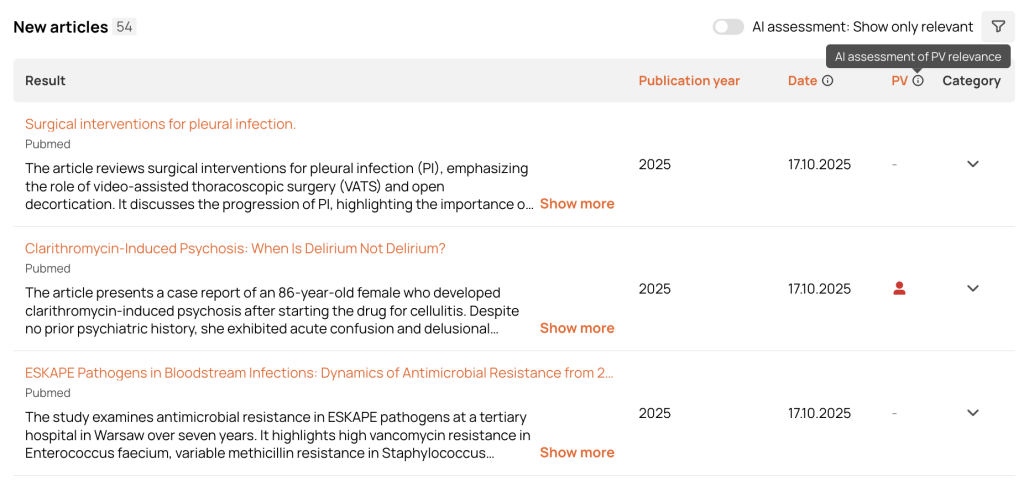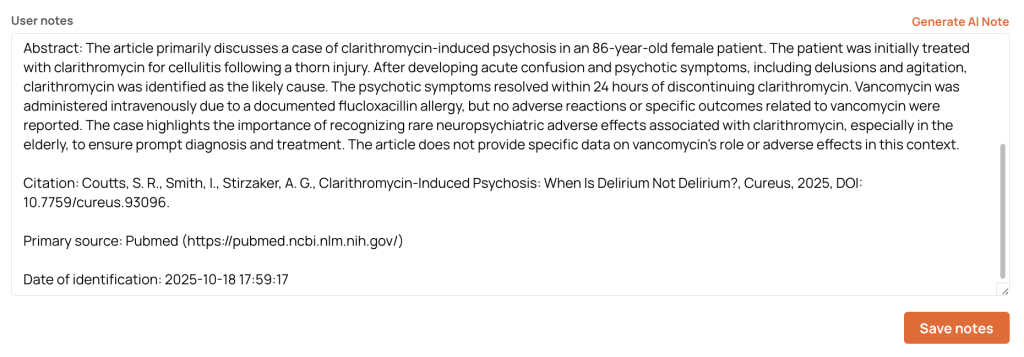Who Reads All the Pharmacovigilance Literature for You with AI
- 20/10/2025
Imagine someone reading pharmacovigilance literature around the clock, never getting tired, never missing critical details, and even telling you, “This is important, pay attention.” This isn’t a perfect colleague – it’s artificial intelligence.
Reviewing medical literature is one of the most challenging and crucial tasks in drug safety. Thousands of new publications appear weekly, dozens of potential safety signals emerge, and the daily hours are limited. Traditionally, experts manually reviewed mountains of scientific articles, case reports, and reviews to ensure no adverse reaction was missed.
Now, the rules are changing.
How AI Is Transforming Pharmacovigilance Literature Monitoring
Modern machine learning algorithms, natural language processing, and automation have turned literature review from a tedious task into a fast, accurate process. Platforms like DrugCard show how AI can handle routine work, allowing pharmacovigilance specialists to focus on analysis instead of endless searching.
1. Speed, Accuracy, and “Red Men”
Previously, specialists manually searched for relevant pharmacovigilance literature. Today, DrugCard automates the process: scanning databases, finding publications by keywords, drug names, and reported adverse reactions.
The platform also prioritises information, highlighting essential articles with a “red man” icon. Specialists immediately know which publications to review first, saving time and focusing on what matters most.

2. Continuous Real-Time Monitoring
Pharmacovigilance literature never stops – new studies, case reports, and reviews appear daily.
AI never stops either. DrugCard continuously monitors new publications, updates databases, and notifies teams of potential safety risks in real time. Pharmacovigilance specialists can detect necessary signals the same day they appear, not days or weeks later.
3. Collaboration Without Chaos
AI-powered platforms make teamwork seamless. Specialists can comment, add notes, and discuss articles in one system.
There are no more endless emails, spreadsheets, or scattered notes. All relevant information stays in one organised location, ready for analysis and reporting.
Tired of spending long, tedious hours writing notes? No worries. The DrugCard platform offers AI-powered note generation – use it, and make your work faster, easier, and more efficient.

4. Data Extraction Without Reading Every Article
No longer is it necessary to manually read dozens of pages from each publication. AI automatically extracts key information, such as study results, adverse effects, and conclusions.
DrugCard provides short summaries directly on each drug’s page. Specialists read a few lines and immediately know whether an article is relevant. Convenient, fast, and revolutionary.

AI Agents – The Digital Assistants of the Future
Do you remember movies in which the protagonist has an invisible assistant who reads everything, analyses data, and highlights the most important points?
It may sound like fantasy, but such tools are approaching reality in pharmacovigilance.
AI agents are the next generation of intelligent systems. They will find and sort pharmacovigilance literature automatically and understand content, interpret context, and explain their reasoning.
Imagine a tool that reads publications, identifies potential safety signals, and explains why it considers them important.
While still in development, these agents aim to help specialists work faster, more accurately, and without routine overwork. You control the process, and AI handles the heavy lifting.
The future of pharmacovigilance literature monitoring with personal digital assistants is no longer science fiction – it’s just a matter of time.
The Future of Pharmacovigilance Literature
AI doesn’t replace experts – it augments their capabilities. Platforms like DrugCard give specialists a digital partner that sees, analyses, and alerts.
What once felt like an endless marathon of literature review is now fast, precise, and futuristic.
The future of pharmacovigilance literature is AI that reads for you – so you can focus on seeing further and making better-informed safety decisions.
If you’re beginning to automate your medical literature monitoring and incorporate AI into your pharmacovigilance work, now is the perfect time to try the DrugCard platform. The first step can be the hardest, but with DrugCard, it’s simple – and it’s the start of a journey toward smarter, faster, and more efficient monitoring.
- 22/12/2025
- Drug Safety


